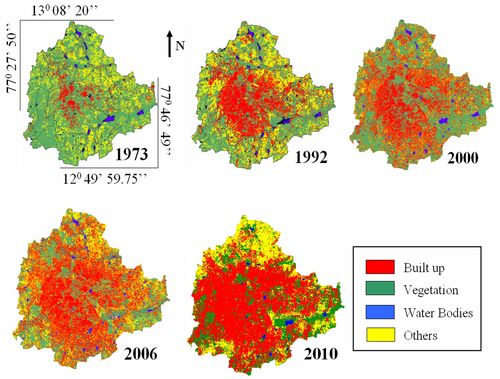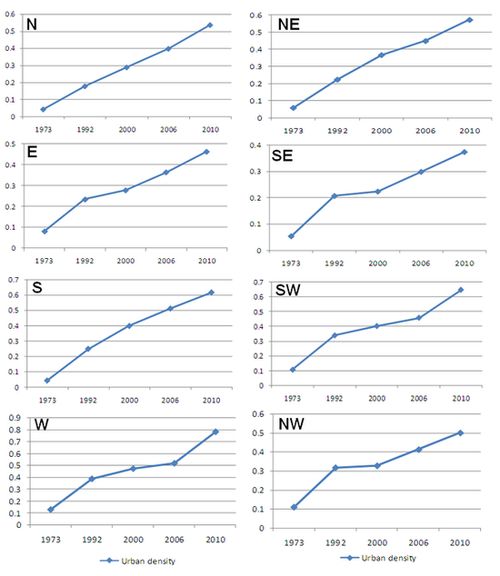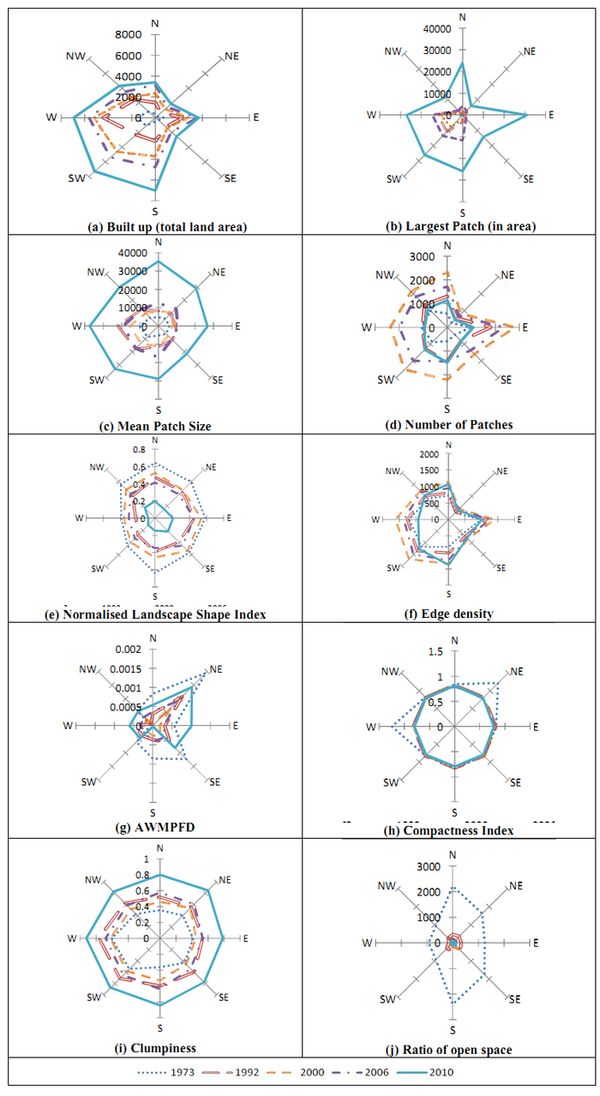 |
Urban Landscape analysis through Spatial Metrics |
 |
1Energy and Wetlands Research Group, Centre for Ecological Sciences [CES], 2Department of Management Studies, 3Centre for Sustainable Technologies (astra),
4Centre for infrastructure, Sustainable Transportation and Urban Planning [CiSTUP],
Indian Institute of Science, Bangalore – 560012, India.
*Corresponding author: cestvr@ces.iisc.ac.in
|
Results and Discussion
The classified images are shown in figure 3 and the statistics are listed in table 2. Overall accuracy for the classified images were 72% (1973), 75% (1992), 77% (2000), 73% (2006) and 71% (2010). Urban density is increasing in all the directions (figure 4) indicating almost a linear growth. There has been a 584% growth in builtup area in the last 4 decades. Vegetation has decreased by 66% and water bodies have reduced by 74%. Urban growth became almost constant in southeast and northwest directions between 1992 and 2000 and then increased linearly. Urban growth is prominent in west, southwest, and south from 2000 to 2010 (figure 5(a)). Largest patch developments have taken place in north and east directions (figure 5 (b)) in 2010 and medium urban development have emerged in west, southwest and south (figure 5 (b)). Separate clusters of huge urban patches have come in north (Bangaluru International Airport) and east (International Tech Park Limited).

Figure 3: Greater Bangalore from 1973 to 2010.
Table 2: Greater Bangalore land use statistics
| Class |
Builtup |
Vegetation |
Water Bodies |
Others |
| Year |
Ha |
% |
Ha |
% |
Ha |
% |
Ha |
% |
| 1973 |
5448 |
7.97 |
46639 |
68.27 |
2324 |
3.40 |
13903 |
20.35 |
| 1992 |
18650 |
27.30 |
31579 |
46.22 |
1790 |
2.60 |
16303 |
23.86 |
| 2000 |
24163 |
35.37 |
31272 |
45.77 |
1542 |
2.26 |
11346 |
16.61 |
| 2006 |
29535 |
43.23 |
19696 |
28.83 |
1073 |
1.57 |
18017 |
26.37 |
| 2010 |
37266 |
54.42 |
16031 |
23.41 |
617 |
0.90 |
14565 |
21.27 |

Figure 4: Urban density in eight directions showing rapid growth rate
Mean patch size (figure 5 (c)) indicates that the city has been growing in circular fashion. Number of patches increased from 1973 to 2000 in all directions (figure 5 (d)) showing urban sprawl. However, the city also continued to become more compact as represented by number of decreasing patches in 2010. NLSI (figure 5 (e)) indicates that the landscape shapes were biggest in 1973 and continued to become smaller with time, having smallest patches in 2010. Mean shape of the patches were smallest in 1973 and largest in 2006 with decreasing trend in 2010. Edge densities increased from 1973 to 2000 and were predominant in northeast, east, southwest, west and south directions, showing a declining trend towards 2010 and indicating compact nature of the city (figure 5 (f)), with convoluted and irregular fringe. Values of AWMPFD (figure 5(g)) indicated that urban boundaries are non-complex structure. The city was less compact in 1973 in north, east and west directions while it became more compact towards 2010 (figure 5 (h)). In 1973, patches were more regular and less in count in northeast and west while from 1992 to 2010, patches became more regular and increased in number. In the year 2010, the urban patches are maximally aggregated, that is, they are clumped together while in 1973, patches were randomly distributed (figure 5 (i)). Ratio of open space was more in 1973 and decreased in all directions in 2010 causing limited lung spaces and greenery for the residents as indicated in figure 5 (j).

Figure 5: Representation of changes in landscape structure described by metrices in 8 directions
|
|
Citation : Anindita Dasgupta, Uttam Kumar, and Ramachandra T. V., (2010), Urban landscape analysis through Spatial Metrics, Proceedings of International Conference on Infrastructure, Sustainable Transportation and Urban Planning, (CISTUP@CiSTUP), Indian Institute of Science, Bangalore, India, 18-20 October, 2009.
|




